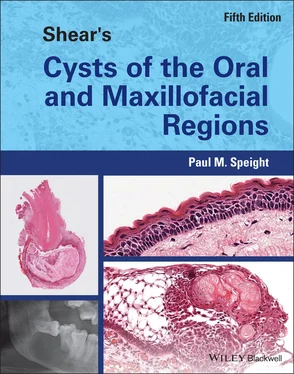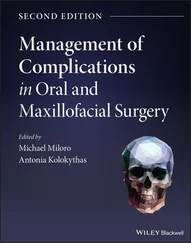Paul M. Speight - Shear's Cysts of the Oral and Maxillofacial Regions
Здесь есть возможность читать онлайн «Paul M. Speight - Shear's Cysts of the Oral and Maxillofacial Regions» — ознакомительный отрывок электронной книги совершенно бесплатно, а после прочтения отрывка купить полную версию. В некоторых случаях можно слушать аудио, скачать через торрент в формате fb2 и присутствует краткое содержание. Жанр: unrecognised, на английском языке. Описание произведения, (предисловие) а так же отзывы посетителей доступны на портале библиотеки ЛибКат.
- Название:Shear's Cysts of the Oral and Maxillofacial Regions
- Автор:
- Жанр:
- Год:неизвестен
- ISBN:нет данных
- Рейтинг книги:5 / 5. Голосов: 1
-
Избранное:Добавить в избранное
- Отзывы:
-
Ваша оценка:
- 100
- 1
- 2
- 3
- 4
- 5
Shear's Cysts of the Oral and Maxillofacial Regions: краткое содержание, описание и аннотация
Предлагаем к чтению аннотацию, описание, краткое содержание или предисловие (зависит от того, что написал сам автор книги «Shear's Cysts of the Oral and Maxillofacial Regions»). Если вы не нашли необходимую информацию о книге — напишите в комментариях, мы постараемся отыскать её.
Shear’s Cysts of the Oral and Maxillofacial Regions
Shear’s Cysts of the Oral and Maxillofacial Regions Fifth Edition
Shear's Cysts of the Oral and Maxillofacial Regions — читать онлайн ознакомительный отрывок
Ниже представлен текст книги, разбитый по страницам. Система сохранения места последней прочитанной страницы, позволяет с удобством читать онлайн бесплатно книгу «Shear's Cysts of the Oral and Maxillofacial Regions», без необходимости каждый раз заново искать на чём Вы остановились. Поставьте закладку, и сможете в любой момент перейти на страницу, на которой закончили чтение.
Интервал:
Закладка:
A further consideration is the use of the term ‘cyst’, which still causes disagreement and some controversy. In pathology dictionaries and general pathology textbooks, a cyst is usually defined as a closed capsule, cavity, or sac‐like structure that may be empty or have fluid or semi‐fluid contents. There is no requirement for a defined lining. Most contemporary oral pathology textbooks, however, choose to define a cyst as a pathological cavity lined by epithelium . Cyst‐like spaces not lined by epithelium have been described as pseudocysts and diagnostic terms such as ‘cavity’ have been used. Kramer (1974 ) defined a cyst as ‘a pathological cavity having fluid, semifluid or gaseous contents and which is not created by the accumulation of pus’. He discussed the terminology and was bemused by the requirement for an epithelial lining, stating that he was puzzled by ‘the definition that demands an epithelial lining’ and said: ‘I am not sure how, or why, the presence of an epithelial lining became included in the definition: clearly it creates difficulties, because so many lesions that have been accepted for generations as “legitimate” cysts must now be termed pseudocysts, or false cysts, or “cysts” in quotation marks’.
The requirement for an epithelial lining probably became enshrined in oral pathology because the vast majority of cysts of the oral and maxillofacial tissues are odontogenic in origin and are lined by epithelium. Thus, the use of alternative terms such as ‘pseudocyst’ or ‘cavity’ clearly distinguishes cystic lesions without epithelium from odontogenic cysts. Although we recognise the term pseudocyst for lesions that are not lined by epithelium (see Chapter 17), we also agree with Kramer and suggest that ‘cyst’ can be used as a diagnostic term for lesions that are clinically or radiologically cystic. This is in keeping with common usage and understanding among clinicians and radiologists. For example, most clinicians, especially paediatric dentists, use the term cyst to describe mucoceles, whether they have an epithelial lining or not, and we therefore retain the diagnostic term mucous extravasation cyst for the non‐epithelial lined cystic lesion caused by spillage of mucus into the tissues (see Chapter 15). Similarly, we are content to use the well‐recognised diagnostic term simple bone cyst for the non‐epithelial lined bone cavity that clinically and radiologically presents as a cystic lesion ( Chapter 17). It should be noted that the definition of cyst does not include a cavity caused by an accumulation of pus, which is defined as an abscess.
In this book we do not attempt to suggest a definitive classification of cysts of the oral and maxillofacial regions, but we divide them into cysts of the jaws , cysts of the salivary and minor mucous glands , and developmental cysts of the head and neck . We discuss cysts that are specific to the maxillofacial regions, and cysts that are not peculiar to these regions are not included unless they have distinctive features that must be considered in the differential diagnosis. Cystic neoplasms such as unicystic ameloblastoma are not included either, although the possibility of a neoplastic origin of some of the odontogenic cysts is considered.
Our classification is intended to be simple and to be particularly useful to pathologists and clinicians who must share and understand definitions and terminology. Many other classifications have been published and may well be perfectly satisfactory. Although readers may use any classification they find valuable as an aid to memory and understanding, they are encouraged to facilitate communication by using the WHO terminology and definitions (WHO 2022a , b).
Classifications
In this edition of the book, the cysts are classified under three broad categories:
1 Cysts of the jawsOdontogenic cysts ( Chapters 3– 12)Non‐odontogenic cysts ( Chapters 13, 14, 16, and 17)
2 Cysts of the salivary and minor mucous glands ( Chapter 15)
3 Developmental cysts of the head and neck ( Chapter 18)
Cysts of the Jaws
Odontogenic Cysts
The odontogenic cysts have been divided into cysts of inflammatory origin and cysts of developmental origin. These are convenient categories, since it is clearly understood that the inflammatory odontogenic cysts arise as a result of proliferation of odontogenic epithelium driven by chronic inflammation, resulting from either pulpitis or pericoronitis. The pathogenesis of the developmental cysts is less well understood, however, and in some cases there is evidence for a neoplastic origin. The pathogenic mechanisms involved in cyst development are discussed in Chapter 2, and details for each cyst type are presented in each chapter. Although these categories are widely used, they are not definitive, since some cysts classified as developmental may have an inflammatory origin. In particular, a variant of dentigerous cyst may be inflammatory in nature (see Chapter 5). In each category the cysts are listed in order of their approximate frequency ( Tables 1.1– 1.3).
Odontogenic Cysts of Inflammatory Origin
1 Radicular cystResidual cyst
2 Inflammatory collateral cystsParadental cystMandibular buccal bifurcation cyst
Odontogenic Cysts of Developmental Origin
1 Dentigerous cystEruption cyst
2 Odontogenic keratocyst
3 Lateral periodontal cystBotryoid odontogenic cyst
4 Gingival cyst of adults
5 Gingival cyst of infants
6 Glandular odontogenic cyst
7 Calcifying odontogenic cyst
8 Orthokeratinised odontogenic cyst
Non‐odontogenic Cysts and Pseudocysts
Non‐odontogenic cysts of the jaws are mostly developmental in origin and arise from vestigial epithelial remnants of ductal structures or from inclusions at the line of fusion of the palatal shelves. The nasolabial and mid‐palatal raphe cyst actually occur in the soft tissues, but are so closely apposed to the maxillary bone that they are included in the classification of jaw cysts. The surgical ciliated cyst is included here because it arises within the alveolar bone of the maxilla. Pseudocysts are not epithelial lined, but are included because they are important in the radiological differential diagnosis of cystic jaw lesions. As discussed above, we are content to use ‘cyst’ as a diagnostic term for the simple bone cyst, since this is clearly understood and widely used by clinicians who recognise that they present clinically and radiologically as a cystic lesion. Stafne bone cavity is neither a cyst nor a pseudocyst, but is an anatomical anomaly causing an indentation of the mandible that appears as a cystic lesion on radiology or imaging. It is often included in classifications and we include it here because of its importance in the radiological differential diagnosis of cystic lesions. Osteoporotic bone marrow defects are controversial lesions, but they present as cystic radiolucencies and must also be considered in the differential diagnosis.
Non‐odontogenic Cysts of the Jaws
1 Nasopalatine duct cyst
2 Nasolabial cyst
3 Mid‐palatal raphe cyst of infants (Epstein pearls)
4 Surgical ciliated cyst
Pseudocysts of the Jaws
1 Simple bone cyst
2 Stafne bone cavity
3 Osteoporotic bone marrow defects
Cysts of the Salivary and Minor Mucous Glands
Cysts affecting the salivary and minor mucous glands of the head and neck are common and may be developmental or reactive in nature. Retention and extravasation cysts (mucoceles) are the most common and may arise at any site associated with minor glands that are found throughout the submucosa of the upper aerodigestive tract and paranasal sinuses. Here we include cystic lesions of the major salivary glands as well as cysts associated with minor glands of the oral cavity and maxillary sinus. Ranula is included as a separate lesion because it has distinctive and specific clinical features and problems of management. Cystic neoplasms are not included. Intraoral lymphoepithelial cysts are included in this category even though their origin is uncertain. Some arise from intraoral tonsillar tissue, while others appear to be associated with dilated ducts of minor salivary gland.
Читать дальшеИнтервал:
Закладка:
Похожие книги на «Shear's Cysts of the Oral and Maxillofacial Regions»
Представляем Вашему вниманию похожие книги на «Shear's Cysts of the Oral and Maxillofacial Regions» списком для выбора. Мы отобрали схожую по названию и смыслу литературу в надежде предоставить читателям больше вариантов отыскать новые, интересные, ещё непрочитанные произведения.
Обсуждение, отзывы о книге «Shear's Cysts of the Oral and Maxillofacial Regions» и просто собственные мнения читателей. Оставьте ваши комментарии, напишите, что Вы думаете о произведении, его смысле или главных героях. Укажите что конкретно понравилось, а что нет, и почему Вы так считаете.












